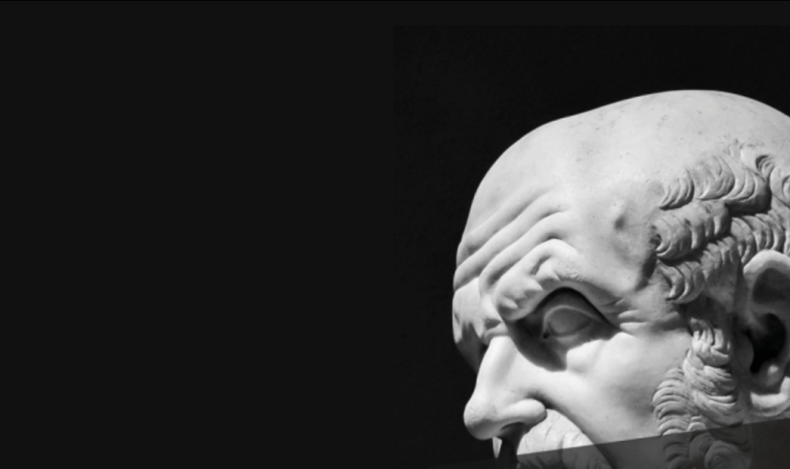Far from being anecdotal, discourse on baldness and practices of distinction based on hair are a central lever in the social and political ordering of ancient societies.
* Lire en Français.
In Rome, civic organisation and the stability of socio-political hierarchies theoretically implied relative physical homogeneity within each social category (senators, knights, slaves, etc.) in order to maintain civic cohesion. This ideal, difficult to apply in practice, associated the slightest detail with a possible distinction, often political, which was subject to the judgement of peers.
As a result, a moral interpretation of physical appearance was often revealed, reinforced by so-called ‘physiognomic’ theories when this specificity was physiological in nature. The further a particular feature was from the Roman ideal of physical appearance based on an aesthetic of virtues, the more it was associated with pejorative values that fuelled the inventory of disqualifying stereotypes. Bald men were thus the target of pejorative stereotypes that portrayed them as drunkards, sexually depraved or effeminate coquettes.
In their book, Robinson Baudry and Caroline Husquin set out to trace the reasons behind this aesthetic, moral and civic disparagement. Treating baldness, whether voluntary or not, as a historical object, the authors seek to analyse the permanence of discourse and representations over time – from the 2nd century BC to the 5th century AD – in order to better understand the different variations that underlie this relatively widespread disparagement.
A new history of the body
In this sense, their approach is firmly rooted in the renewal of studies on the body that began in the 1990s and later spread to ancient history. By examining everyday objects, which we might call ordinary, and which may seem insignificant, the aim is to analyse their cultural construction over time and thus propose a political and anthropological history.
While a history of hair has already been proposed for other periods (Marie-France Auzépy, Joël Cornette [eds.], Histoire du poil, Belin, 2017), particularly for Greek Antiquity (Pierre Brulé, Le Sens du poil, Belles Lettres, 2015), the study of baldness remains a novel subject for the Roman world and offers an effective synthesis, given the limited number of sources available to us. Far from offering a simple typology of baldness, the authors succeed in providing an in-depth analysis of the examples used to shed light on structural logics. These logics then make it possible to propose a political history, not of baldness, but based on it.
Combining detailed case studies with general, almost methodological developments, the book presents this history with remarkable clarity, allowing a wide range of readers to understand the issues raised by the nature of the sources used (iconography plays a minor role in this regard).
Spreading the stereotype
After a general introduction that outlines the issues of the period in light of recent historiographical contributions, the book begins with the thorny question of definitional issues, i.e. how the ancients viewed baldness and, more broadly, body hair. Hair was subject to a whole set of norms, the mastery of which, particularly in terms of technique (hair removal, shaving, etc.), made it possible to meet physical expectations, which by definition changed over the decades but were always structured around the decency of the citizen. Baldness is thus at the opposite end of the spectrum from the civic ideal, and bald people are therefore burdened with several stereotypes that distance them from social and physical norms. This raises the question of physical beauty and masculinity according to criteria specific to the elite.
Discourse and representations thus promote social determinism. Younger people with premature baldness are considered more likely to engage in indecent behaviour (drunkenness, sexual depravity or excessive coquetry). The spread of these ideas throughout society (urban plebs, soldiers, etc.) can be observed, in particular in the large number of medical treatises aimed at providing remedies to treat this embarrassing baldness, which can damage one's reputation, and sometimes, lead to shame. Whether Hippocratic or magical, medicine often offers several solutions for preserving or regrowing hair. Nevertheless, given the high prices of certain remedies, particularly those made from exotic ingredients, several treatises proposed alternatives that were more accessible in Rome: bear fat, mustard, labdanum, animal excrement.
Furthermore, certain remedies for baldness already hinted at one of the major issues surrounding the subject, namely voluntary baldness. Despite the link between baldness and sexual deviance also established by doctors, they exceptionally suggest shaving the head to aerate the pores of the skin, and thus treat certain headaches, despite the risk of public disapproval.
‘Stigmas’ and socio-political hierarchies
While the first part of the book aimed to better define the subject, the second part focuses more specifically on the issue of stereotypes and prejudices that can often be detected in the mockery of bald people, such as Caesar, who was mocked by his troops in 46 BC. While the issue is not so simple, insofar as baldness is sometimes valued, as it can signal the wisdom of old age (as perfectly illustrated by the statue of the Togatus Barberini with aged features), prejudices are often based on moral considerations. Historical analysis therefore focuses on identifying the social, economic and political reasons behind these disparaging remarks.
Given the negative connotations associated with this physical characteristic, voluntary baldness is met with incomprehension by a large part of the population, especially in the case of the priests of Isis, whose bodies do not conform to any Roman standards. This lack of understanding can be explained above all by the fact that shaving the head is indicative of civic and legal status. Indeed, this practice was commonly reserved for slaves who had been promised their freedom, which in many ways can be equated with a stigma, insofar as it further reveals a subordinate status to everyone. Similar to a ‘rite of passage’, hair cutting signalled a change in status, as is also the case for a child who shaves off his first beard to mark his transition to adulthood. Nevertheless, a shaved head is indeed the mark of people with a lower status, since actors (whose profession was considered lowly and undignified) also had no hair. What's more, shaving the head was more commonly reserved for fugitive slaves and those sentenced to hard labour: accompanied by branding, it was a real stigma in these cases.
The shaving of hair thus sheds light on the mechanisms of control in a slave-owning society, where social and statutory hierarchies must be read directly on the body. Control of the self, but also of the population as a whole, thus appears to be one of the fundamental issues addressed in the book, as it implicitly questions the very definition of bodily deviance based on hair. It is therefore the constraint on bodies that is at the centre of the discussion here, as illustrated by an episode during the revolt of the brigand Bulla Felix in 206 AD, when the rebels shaved the head of a captured centurion: by this gesture, they transferred their stigma and, ultimately, reversed their status.
This inferiorisation through the body is sometimes used by ancient historians to assert Roman domination over the Mediterranean basin. Thus, in 167 BCE, Prusias II, king of Bithynia, is said to have shaved his head to show his submission to the Roman Senate, just as several foreign princes are said to have had their wives' hair cut to signify their mourning following the death in 19 CE of Germanicus, who was tipped to succeed Tiberius. Admittedly, the authenticity of these episodes is questionable, but they testify to the value placed on hair as a symbol of domination in a society, where hierarchy was expressed particularly through appearance.
Baldness as a tool of political disparagement
The last part of the book appears to be the core of the authors' reflection, insofar as it offers a political analysis, not of baldness, but of the discourse surrounding it. Following a chronological plan structured around major academic periods (the Republic, the High Empire, Late Antiquity), these analyses are not intended to be exhaustive, but focus on specific cases, such as trials during the Republican era, in which baldness could be used as an argument to reinforce the charges brought against the accused. In a military context, several insults directed at bald people, shouted aloud or written on slingshot bullets, associate baldness with sexual passivity: this is evidenced by the insults directed at Lucius Antonius, the brother of Mark Antony, who was besieged in Perugia in 41 BC and whose slight baldness is also attested to by his monetary issues.
The section devoted to the High Empire focuses on the study of emperors and the logic behind the writing of their biographies. An introduction first sheds light on the biases conveyed by aristocratic sources, which primarily reflect the nature of the relationship between a particular emperor and the Senate. The emperors' bodies, as described by biographers, must therefore be considered from a moral and political perspective, rather than as a realistic representation. It is thus easy to understand why the first bald emperor mentioned by Suetonius is Caligula, when we know from Tacitus and Cassius Dio that Tiberius was also bald. The answer simply lies in Caligula's relationship with the Senate. Baldness appears to be one of many flaws which, when combined, paint a picture of a bad emperor. According to Suetonius, Caligula's jealousy led him to shave the heads of all the people with beautiful hair he came across, in order to ‘disfigure’ them. Finally, after Domitian, described as a bald Nero by Juvenal, the baldness of emperors was no longer mentioned, signalling a shift in the physiological considerations and values exalted by the aristocracy. This phenomenon is clearly attested from the Antonines onwards (2nd century AD), when total or partial baldness occupied an increasingly important place in imperial statuary, in order to highlight the wisdom that comes with age.
The last section of the book focuses on the Eulogy of Baldness , written in the early 5th century by Synesius of Cyrene (c. 370-413), the future bishop of Ptolemais. It is the only direct testimony of a bald man on his baldness that we have preserved from Antiquity. Written in the strictest tradition of rhetoric, the work is intended as a response to the Eulogy of Hair, written by Dion of Prusa three centuries earlier, which would have offended the sensibilities of this Greek notable. To this end, the author, who expresses an ‘emotional attachment’ to his now lost hair, turns all the disqualifying characteristics of baldness into moral, physical and intellectual qualities. This paradoxical eulogy allows the author to refute all the stereotypes, some of which date back to the Republican era (ugliness, stupidity, cowardice, debauchery, etc.). In his writing, it is the hairy who ultimately become effeminate, as he is forced to take great care of his appearance. Dion of Prusa's argument that hair is a sign of courage, as evidenced by Spartan practices, cannot be supported, since the Lacedaemonians were defeated at the Battle of Thermopylae after spending too much time brushing their hair the day before. On the contrary, since Alexander's troops shaved their heads before the Battle of Gaugamela, where they were victorious, it is indeed the bald who prevail by force.
In conclusion, the authors emphasise the misleading similarities between our societies and those of Antiquity, in order to better highlight all the differences between them. The ‘territory of differences’ that is Antiquity, as Florence Dupont pointed out, can only present ambiguous analogies: the prejudices against -or in favour of- our own bald people are not those of Antiquity.

